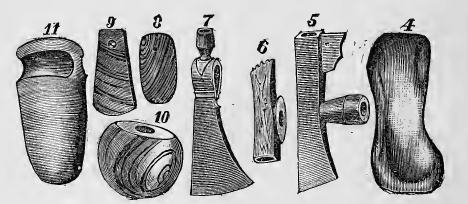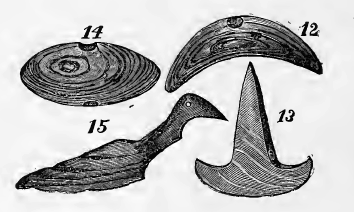Links
- Ahnentafel Charts
- Biographies
- Birth & Baptism Records
- Cemeteries
- Death Records & Obits
- History of Auglaize County
- Links
- Marriage Records
- Query Message Board
- Surname Registry
Within the last few years great interest has been awakened, touching the antiquities of the pre-historic and Indian races of America. These races, destitute of a written language, have left their history only in landmarks, consisting of mounds, effigies, fortifications, implements, and hieroglyphics. The most ancient of these races have marked their occupancy everywhere by the erection of mounds of different characters, on which account the races have been designated the mound builders. In this State alone, about thirteen thousand mounds, fortifications, and inclosures have been found. These display great engineering skill, particularly in the construction of inclosures and other works of defence, and must have required great periods of time for completion.
These mounds are the great depositories of ancient Indian art, and are standing monuments of a skilled people who preceded the savages found at the advent of the whites. These latter tribes have used the mounds of their predecessors as burial places, which accounts for the imperfect forms which some of them exhibit. Mr. J. B. MacLean, in "The Mound Builders," says, "The difference between the ancient and more recent deposits is easily told. In the latter, the stratification is broken up, while in the former, it still presents its original integrity."
Implements belonging to both the mound builders and Indians are found scattered throughout this county. Many relics have thus been discovered, but where they are found upon the surface, it is impossible to determine to which race they belonged. That the mound builders lost many implements in the chase is undoubtedly true, while we know the same thing to be true of the Indians; and at the same time the Indians confess to having appropriated the implements of a former and more skilful race. Though few, if any, mounds or embankments exist within the county to be attributed to the mound builders, yet the bones and implements exhumed from the three ridges which cross the county are indicative of the occupancy of this section by this ancient people.
The following engravings represent some of the most interesting implements found in the county.

Fig. 4 is a cut of a stone implement found in an old grave on the site of Wapakoneta. It is believed by many to have been used as a last by the chief Waughpaughkonetta, who is reputed to have been club-footed. The burial of such articles in the grave of their possessor was an Indian custom.
Fig. 5 represents a red stone pipe which was ploughed up near Wapakoneta, and is now. in possession of Dr. C. Berlin. Its general appearance is excellent, and even graceful, being formed of the red pipe stone, so highly prized by the Indians. It is beautifully polished, and the workmanship, as a whole, displays great skill.
Fig. G represents a pipe found on the farm of Thomas Sehoonover, in Moulton township. It is now in possession of C. W. Williamson, of Wapakoneta. It is of the same variety of stone as figure 5, and exhibits the same excellence of workmanship. On one side it bears the rude sketch of a fish.
Fig. 7 represents a combined tomahawk and pipe, which was found two miles south of Wapakoneta. It is probably of French manufacture. The pipe-bowl has been turned in a lathe. The material is steel, and the workmanship excellent.
Figs. 8 and 9 represent different forms of a stone ornament, known as a pendant or gorgon, which was probably suspended upon the breast, or from the terminal lobe of the ear. Dr. C. C. Abbott, in his work "The Stone Age in New Jersey," says, "At any rate, it was designed for ornament, and not for any other purpose, as has been suggested, such as a fishing-line weight, or a sinker." The holes in these pendants, and other Indian implements, have always been a puzzle to archaeologists. One of the authors of the "Ohio Centennial Report on Archaeology" says, "I think we must give up the theory that the various forms of polished slate, perforated at right angles to the face, were used as sizers and twisters of twine or strips of skin. They are all bored with a taper, which leaves a sharp edge, either at one end, or in the middle of the piece. Those that are more or less worn, present the appearance of having been suspended. Thread twisters and sizers were probably made of wood and bone, like the Iroquois shuttles figured by Mr. Schoolcraft. Some of their perforated stone implements somewhat resemble ours in general form. Most of the striped slate relics I am inclined to place among the ornaments, badges, and armor of the ancient tribes. Some of them would answer all these purposes. The tapering holes are good contrivances for fastening by thongs of raw-hide to a bell-string, or piece of wood. Supposing the head or knot of the thong was let into the bored hole, these plates might be firmly bound to each other, or to the body of the wearer, and the holes not be much worn by the process."
Fig. 10 represents a specimen from Dr. Berlin's cabinet. It is formed of fine-grained green slate, striped with dark bands, as are all the specimens figured, except 4, 5, 6, 7, and 11. It would be difficult to tell the use of this instrument. It is too large for a bead, and can scarcely be considered a badge of authority. Being flattened on one side, suggests the possibility of its use as a whistle. Arclneologists class it under the general head of tubes.
Fig. 11 is a representative stone axe, found in nearly every locality in the State. "They are not abundant in the mounds, but are found in large numbers in the valleys. They are fashioned with great skill, of rare and beautiful material, the predominant series being granite. They are found with and without grooves for the adjustment of handles. Those designed to be wielded by both hands have an average weight of ten pounds, although they vary from one to sixteen pounds. The smaller varieties, called hatchets, were used in war, as well as for domestic uses. These weigh from one to two pounds, are destitute of grooves, and are of all sizes, from two to twelve inches. They also vary greatly in design, some having holes for the reception of handles. They are all, for the most part, polished, and some have been ground and polished with elaborate care."
C. W. Williamson has in his possession a stone hoe, or adze, made from the same material as these axes. It resembles the stone axe in every respect. The upper side of the implement is straight, while the under side is bevelled.

Fig. 12 is a beautiful specimen, that may be classed under the head of banner stones. In outline, finish, and perforation, it is faultless. The hole passing through the middle is a very noticeable feature, and measures less than nine-sixteenths of an inch in diameter. It is circular, of uniform dimensions from end to end, and faintly exhibits those rings which characterize holes, drilled with a hollow instrument.
Fig. 14 represents a second example of this perforated ornament, or banner-stone. It is shorter and thicker than fig. 12, but is well made, and drilled with the same smoothness and beauty.
Fig. 13 is a partial representation of a very interesting form of banner-stone. The portion above the perforation is imaginary; and, after reference to Dr. Abbott's work, we incline to the belief that, if the upper portions were made to resemble the lower, it would probably be correct, as that author believes these parts to be alike.
"This form of badge being one of the most elegant and expensive, was probably used to indicate the highest rank of office. The single crescent probably signified a rank next below the double."
Fig. 15 is a curiously wrought imitation of a bird. The knob-like protuberances, representing eyes, stand out from the head one-eighth of an inch.
The bottom of the specimen, as the engraving shows, is flat, and contains three holes, extending upwards about half way through the body. Its use is not determined.
Among the many other interesting relics found here, is a stone pestle used by the Indians to convert corn into meal. It is seven inches in length, and four and a half inches in diameter at the base, and takes the perfect form of a druggist's pestle. But few of these have been found in this locality, while the one in point is the most perfect specimen we have seen. It was found at the old home of the chief, White Feather, near the present site of Buckland, and is in possession of Robert C. Means of Wapakoneta. A stone mortar was also found in the same vicinity, which, from the statements we have received touching its form and size, we are led to believe they were used together; but as we have not had the privilege of examining it, we cannot give a minute description.
In connection with these principal specimens, many others of less importance have been gathered within the county; but as these are of a commoner character, a full description would exceed the limits of this work. For a complete elucidation of the subject, the reader is referred to Mr. MacLean's work on "The Mound Builders."
From "History of Auglaize County, Ohio, with the Indian History of Wapakoneta, and the First Settlement of the County", Robert Sutton, Publishers, Wapakoneta, 1880